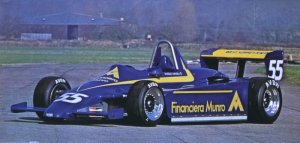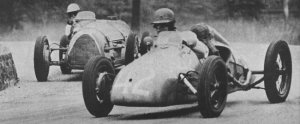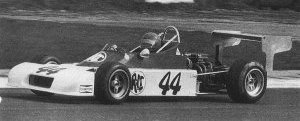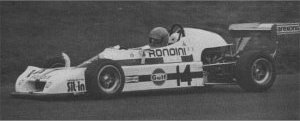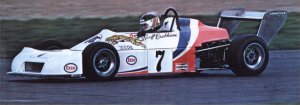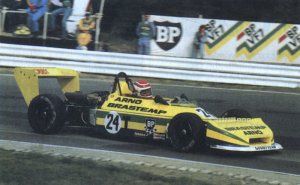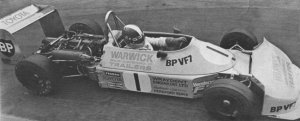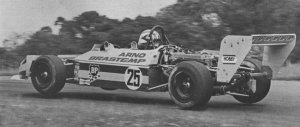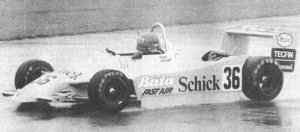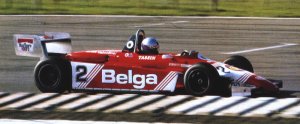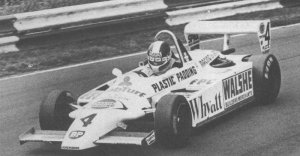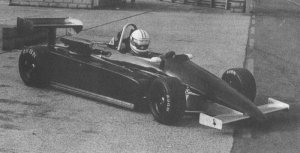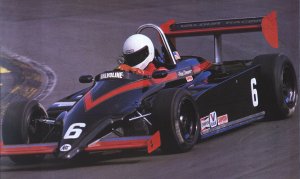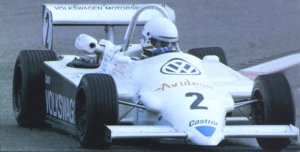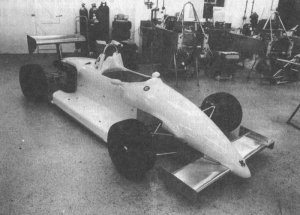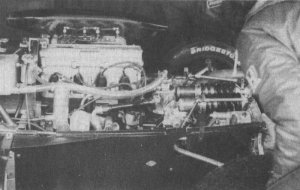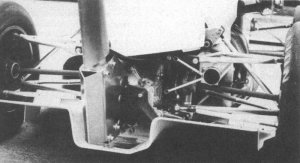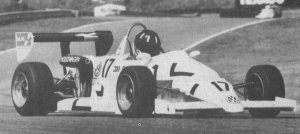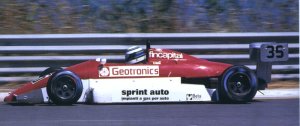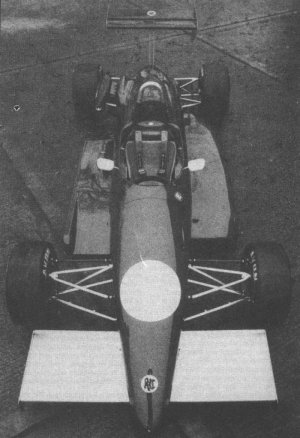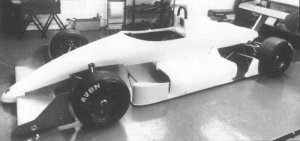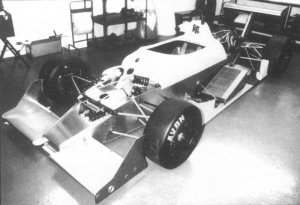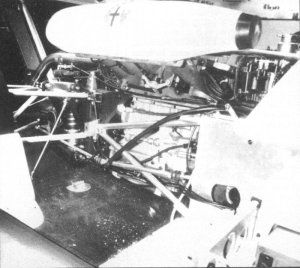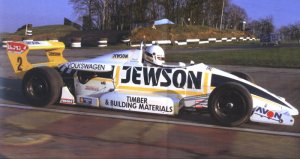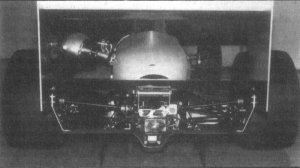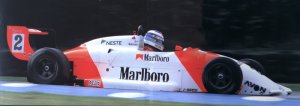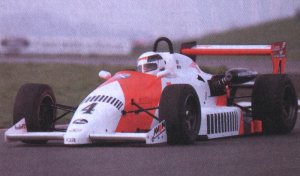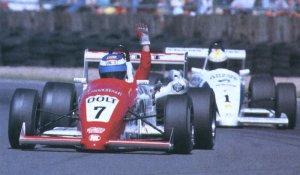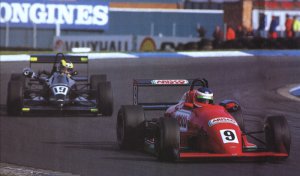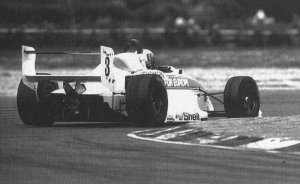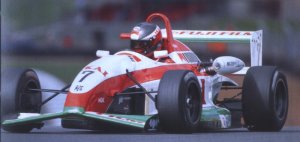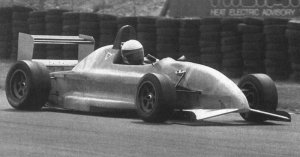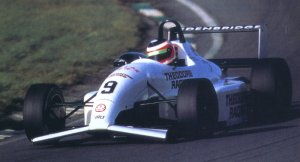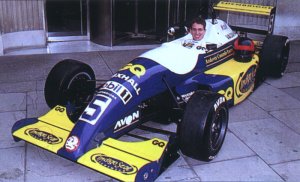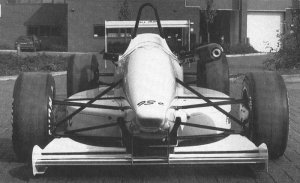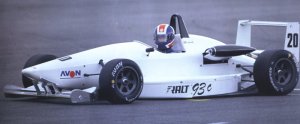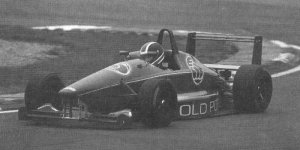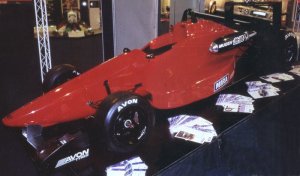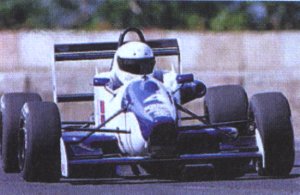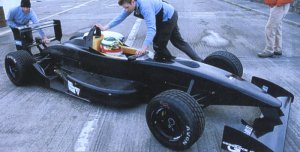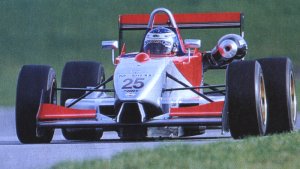 |
 |
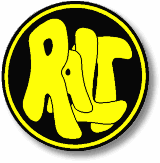
Ron Tauranac was the designer behind the Formula 1 World Championship winning Brabham Grand Prix cars of the 1960's and when Bernie Ecclestone bought out the company and after doing a number of freelance projects Tauranac decided to set up business on his own account. Ron started in racing in 1946 in his native Australia when with his brother Austin Lewis (Ron + Austin + Lewis + Tauranac= RALT) he began building cars for local competition events.
|
Ron
Tauranac in the Ralt Mk1 in Australia in the
early 1950s. Following him is Stan (father of Alan) Jones in his Maybach Special. |
Ron himself competed
in hillclimbs during the 1950s where a fellow competitor and later friend
was Jack Brabham. By 1959 Ron was ready to accept Jack's invitation to
join him in England to set up Motor Racing Developments and begin the
long run of very successful works and customer cars. Numerous race wins
were taken in F1, F2 and F3 with both Jack Brabham and Denny Hulme winning
the World Drivers Championship and Brabham taking the Constructors Cup.
For several seasons Brabham dominated F2 and especially F3 as customers
favoured the cars' blend of simplicity, ease of maintenance and most importantly
their sheer competitiveness. Eventually when Jack retired Ron bought Brabham
and ran it for a year before selling it onto Bernie Ecclestone.
After a period that included designing the Trojan F1 and F5000 cars and
working for Frank Williams Ron decided he wanted to get back into designing
customer cars so in 1974 Tauranac set up the Ralt factory at Woking in
Surrey and in 1975 the first Ralt, the RT1, was produced. The design philosophy
behind the RT1 was to build a strong, reliable and easily maintained customer
car that would be eligible for a number of classes, primarily Formula
2 and 3, and in the USA Formula Atlantic. Such was the success of the
Ralt marque that by 1984 the 500th Ralt was delivered. In 1988 March bought
out Ralt and Tauranac stayed on as a consultant, for the next couple of
years March continued to win a lot of races but into the early nineties
the Ralt star faded along with that of March. In the early nineties the
93C and the 94C turned out to be complete disasters and the Ralt name
dropped out of F3 with hardly a ripple. At the end of the decade there
was a surprise return to racing and although early results were disappointing
Ralt returned to the UK championship in 2002.

| The
first F3 Ralt, the RT1, consisted of a 16-gauge L72 aluminium monocoque
with a steel subframe behind the cockpit. This consisted of two tetrahedron
frames that ran to the bottom of a square frame that attached to the
Hewland gearbox, a pair of tubular brackets secured the engine to
the back of the tub. Additional braces located the top of the frame
to the engine adaptor plate. Double wishbone suspension with outboard
springs and dampers was employed at the front whilst a single top
link, reversed bottom wishbone and twin radius rods were to be found
at the rear, also with outboard springs and dampers. The radius rods
were attached to the outer corners at the rear of the tub via steel
plates. The front of the car used a large full width fibreglass nosecone
whilst a wing was attached to the gearbox at the rear via a tubular
frame. Brakes were solid 10.5 in. discs front and rear. The car was on the pace immediately with Larry Perkins going well in the UK winning twice at Brands Hatch as well as taking a first at Monza and Bertram Schäfer taking a number of top three places in the German Championship including a win at Ulm. Track: front 50.25 ins. rear 51 ins. |

| A
number of small changes were introduced for 1976, the most noticeable
was a new nose cone design with rounder lines and an adjustable splitter.
In addition the forward braces for the roll hoop were repositioned
closer to the hoop, presumably for driver comfort. The track was also
narrowed to 47.375 ins. at the front and 48.5 ins. at the rear. Results were good without being spectacular, once again Bertram Schäfer went very well taking three wins. |

| For
1977 Tauranac introduced a few more small changes to his design, new
elliptical bodywork was fitted. The intention had been to use this
from the beginning but Tauranac held off as he felt customers would
not like it as it made the car look bigger than it actually was. In
addition changes to the technical regs meant that the rear wing now
attached to the rear of the gearbox by a large diameter tubular steel
crossbeam that doubled as the oil catch-tank. The RT1 seemed to hit its stride in 1978 and although there were only two wins in the UK for Geoff Brabham on the continent the Ralt took nineteen major wins with Anders Olofsson taking the runner-up spot in the European Championship and won the Swedish crown whilst Elio de Angelis took the laurels in Italy although two of his four wins came in a Chevron. |

|
There
was a relatively major redesign carried out to the engine spaceframe
for 1978. In effect the twin tetrahedrons were flipped so that instead
of the main spar running along the bottom of the tub with the "hypotenuse"
going from the base of the roll hoop to the bottom of the gearbox,
the main spar now ran from the base of the roll hoop to the top of
the gearbox with the "hypotenuse" going from the bottom
of the tub to the top of the gearbox. The square frame around the
gearbox was replaced with a cast aluminium crossbeam bolted to the
top of the gearbox to which the top link and damper were mounted.
A cast magnesium bracket bolted to the bottom of the gearbox to take
the lower wishbone. The radius rods now attached to the top and bottom
of the tetrahedrons where they were bolted to the tub. The lower radius
rod had a choice of three mounts to adjust the rear castor. The wishbone
design was changed with an additional pair of plates to take the rearward
attachment for the lower radius rod, previously it had been located
on the wishbone via a clevis bolt. Some teams tried fitting the wide track F Atlantic suspension which seemed to make the car more stable and improved its handling in mid-speed corners. Also some teams fitted adjustable roll bars and went to great lengths to lighten the cars. The RT1 dominated the UK scene winning 24 of 29 races with Nelson Piquet and Derek Warwick ruling the roost. Similarly the European Championship was dominated by Jan Lammers and Anders Olofsson who won eight races between them, Olofsson took the Swedish Championship again and Bertram Schäfer came out top in Germany. |

| 1979
saw ground-effect arrive in F3 and constructors such as March, Chevron
and Martini soon had their wing cars up and running, some with more
success than others. The RT1 continued to be used by many drivers
and although it was still capable of getting its driver on the podium
it was no longer a winner. Thus the RT3 was born, it would soon become
one of the most successful F3 designs ever. Comprising a very stiff
aluminium tub with honeycomb bulkheads, suspension was inboard all
round with the fuel tank located centrally. The tub was very narrow
which allowed for wide, skirted sidepods for maximum ground-effect.
The whole thing was enclosed in a very stylish body. Early indications gave no clue as to its winning future, production was slow and only a handful of cars were built. Initially the car was a little heavy and it took drivers time to get used to it. The best result was probably a third at the Nurburgring in a German Championship round for Georg Bellof. |

| Not surprisingly perhaps in view of its slow start in 1979 most drivers preferred the more proven March/Argo option for 1980 and it was not until round six of the British Championshiop that a RT3 appeared. However the chassis now began to show its worth as testing refined it and drivers got the knack of setting it up. Fortunately for Ralt front-runner Stefan Johansson was, like all other 803 drivers, having trouble with the latest March finding it very inconsistent. His Project Four team (owned by Ron Dennis) decided to switch to an RT3 for the closing races of the year and Johansson immediately took pole position for, and walked away with, the final four races to win the Vandervell British F3 Championship. It was a similar story in Germany where the RT3s of Frank Jelinski and Wolfgang Klein took first and second in the German Championship. |

| The RT3/81 was a lightly revised version of the 1980, it featured a strengthened engine bay and reprofiled sidepods. In the UK the RT3 dominated the Marlboro Championship taking eight of the top ten places and winning nineteen out of twenty races. During the season Tauranac introduced revised suspension geometry based on the USA spec F Atlantic car. It was a similar story in Germany with the RT3 taking 5 of the top six places in the championship. It was only in the European Championship where the RT3 suffered it seemed unhappy on the European tyres although it was only at the final race that a RT3 appeared on the Michelin tyres that largely dominated the series. |

| The
1982 RT3 continued the evolution of the original model and as its
success increased more and more teams switched from other manufacturers,
especially now that March were no longer building F3 cars. A number
of the more experienced teams began to experiment with minor modifications
to the design, notably to the bodywork, in an effort to gain an edge
(however small) over their fellow RT3 users. The Marlboro British Championship saw an almost total Ralt dominance, 20 wins out of 20 and 117 point scoring finishes out of 120. In Germany it was a RT3 1-2 finish in the championship whilst the only RT3 in Japan took the F3 Challenge Cup by a comfortable margin and both the French and Italian championships went to RT3 drivers. It was only in the European Championship that the RT3 suffered due to a lack of a concerted effort by any teams running a RT3. Nevertheless James Weaver took three wins and a second in only four races in the Eddie Jordan car to show what might have been with a full season season. |

| Further
evolution was the name of the game for the RT3/83, the sidepods were
reprofiled once again, the rear end was further stiffened and there
were slight suspension geometry modifications. Most obvious change
was a new tub with a revised footbox area as a result of new FISA
regulations. These design changes led to a more aerodynamic bodywork
that featured a reprofiled pointed nosecone. Unfortunately the F3
cars were now suffering from the same problem that was ruining Formula
1, the cars were loosing aerodynamic efficiency as soon as they sat
in the dirty air of another car. Once again it was total RT3 dominance in the British Championship with Ayrton Senna and Martin Brundle winning 18 out of 20 rounds with the RT3s of Allen Berg and Calvin Fish taking the other 2 races. It was a similar story in the European Championship with every round going to a RT3 and the top nine places in the final standings going to RT3 drivers. Things were slightly different in the national championships, Anson took the German Championship with RT3s second and third, it was a similar story in France, Martini first, Ralt second and third. Italy, Japan and Sweden saw the status quo returned with RT3 drivers winning both championships. |

| For
this, the final incarnation, of the RT3 the most obvious change to
the design was the adoption of a pushrod front suspension in place
of the previous rocker arm design. Some drivers found the revised
front suspension made the car more nervous and they reverted to the
older system although most agreed that the pushrod system had more
potential given sufficient sorting. Further rear-end strengthening
and sidepod reprofiling were also introduced. Some teams also adopted
the stronger Hewland FT200 gearbox in place of the more usual Mk9.
In the Marlboro British Championship it was business as usual, 17 rounds, 17 RT3 victories with Johnny Dumfries dominating, he won 10 rounds in all. In addition with the exception of one sixth place for Magnum every single point position went to RT3s. The B Class championship was also a RT3 benefit with the top seven places being sewn up. In Germany and Italy it was a RT3 1-2-3-4 in their respective championships whilst it was a top ten clean sweep in Sweden. Only in Europe and France did the RT3 stumble. Ivan Capelli took the European Championship in the Martini MK42 but his win was tainted after his car was found to have an illegally modified airbox at Monza and he was disqualified. RT3s took the next four places. In France it was a Martini home win with the MK42 taking the top five places. |

| Continuing
with the RT3 design was no longer feasible for 1985 with the introduction
of the new flat bottom regulations so Tauranac came up with a new
design, the RT30. The new car was clearly related to the RT3, at least
as far as looks went but under the skin it was another story. Most
obvious difference was the low sidepod on the right, Tauranac had
spotted a loophole in the regulations as regards the the size of the
deformable structure required and he used this to improve the aerodynamic
advantage of the car. He also utilised the "coke bottle"
shape pioneered by the McLaren F1 team to further aid the downforce
available. At the rear a new development was fitting longitudinally
mounted shock absorbers on the top of the gearbox. The car retained
an aluminium tub with a honeycomb dash panel despite main rival Reynard
taking the composite option. The chassis was 4 inches longer that
the RT3 and a tubular "A" frame was used at the rear to
mount the engine. Tubular steel wishbones were employed front and
rear with pull rod operated dampers. For the first time Tauranac used
a bell housing oil tank. The new flat floor was made from varnished
wood and extended from the front of the pods to the rear where it
joined to upswept sections. Not surprisingly the car was another Tauranac winner although Reynard was a very serious threat. An early season change to the front suspension geometry saw the car easier to balance and it began to win. Mauricio Gugelmin took the British Championship with three victories and Dave Scott, Gary Evans and Gerrit van Kouwen also took UK wins. To nobody's surprise the new Class B for year old cars was a RT3 benefit with wins at every round, final victory going to Jamaica's Carlton Tingling. Results on the continent were good without being brilliant, Michel Trollé took third in the French Championship whilst in Germany Kris Nissen and Adrian Campos were second and third. In Japan the RT30 of Kouji Satou took first place ahead of the similar car of Aguri Suzuki. |

| The
old, familiar, and very successful, Tauranac evolutionary ploy was
used in 1986 when the RT30 became the RT30/86. Utilising the same
nose and cockpit as the '85 model the two cars looked very similar
but there were a number of significant changes. At the rear the dampers
were moved back to a vertical position as wind tunnel testing showed
a lower cleaner underwing was the way to go. The rear uprights were
new allowing the lower wishbones to be lifted above the one-piece
rear floor. Inboard the wishbones attached to a new combined bellhousing
and oil tank. A modified left-hand sidepod contained a new smaller
copper radiator. The tub was still aluminium honeycomb but was generally
tidied up to make it more user friendly. The RT30/86 was generally very successful, although the British Championship went to Andy Wallace and his Reynard the next 11 places went to Ralt. The German and Japanese Championships fell to Ralt and the chassis did well in both France and Italy despite coming up against hordes of Martinis and Dallaras. The car did gain a reputation for being hard to get the maximum out of and a few drivers tried switching to Reynard in the UK but didn't go any better so perhaps it was a psychological problem than anything else. |

|
For 1987 a new car was introduced, the RT31, although it looked very similar to the RT30 it was in fact a largely new car in all respects. Rather than the previous aluminium honeycomb the tub now used outer skins internally clad with honeycomb composite panels tightly fitting between the bulkheads. The new design was claimed to increase rigidity as well as giving greater energy absorption in the event of an accident. At the front the springs and dampers were now mounted above the footbox and angled to the rear (they were angled forward on the RT30/86). The bulkhead forward of the dash hoop that takes the spring loadings was machined from solid on a CNC lathe. The tub itself was three inches longer between the engine and cockpit than on the 1986 car both to improve the driveability and to allow the fitment of an improved fuel collection system. The whole car was slimmer than the RT30/86 which meant that wider, deeper front wings were fitted without interfering with the airflow to the oil and water cooling systems in the left-hand pod, the water radiator size was increased by 25%.The flat floor was made from plywood which merged into the composite diffuser at the rear. The car now featured a contoured head fairing on the very smooth bodywork. Suspension was double wishbone all round with pushrods and "nodders" operating the dampers. The gearbox was a Hewland 5-speed with the option of a 6-speed at extra cost. Track: front
56 ins. rear: 52 ins. The RT31 was up against some very tough competition from both Reynard and Dallara and results were mixed. In the UK honours were pretty much even with Reynard and Ralt winning nine races each although Johnny Herbert won the Championship in a Reynard. The RT30 took second to fifth in the B Class Championship. In France the RT31 was second and third behind the Dallara of Jean Alesi. Understandably in Italy it was all about Dallara and fourth in the final German standings was the best result for a RT31. Ross Cheever won the Japanese title splitting his time between an RT30/86 and a Reynard 873 whilst most of the next places went to either RT31s or RT30/86s. The lower key Swedish Championship went to the RT31 of Micke Johansson. |

|
Once
again the new RT32 looked very similar to the previous RT31 design
but yet again it was substantially different on a closer examination.
The most significant change was that for the first time Tauranac
employed composite technology in one of his F3 cars. As in previous
years aluminium honeycomb was used in the lower section of the tub
but the top portion comprised of carbon fibre, the two sections
being bonded together. The reason for using the two differing materials
was given as offering the driver better protection in an accident.
In addition a 110% increase in torsional rigidity was gained. Another
major design change was to lower the engine installation by 30mm,
this involved major modifications to the engine and drive train.
All the major engine suppliers produced units with smaller flywheels
and modified sumps whilst Hewland produced a new gearbox with a
strengthened magnesium casing that also gave a 5kg weight saving.
Following wind tunnel testing several minor changes were made to
the body design, a shorter left-hand sidepod was fitted with a modified
radiator and both pods were fitted with deflectors. The exhaust
system ran up the centre of the engine cover to reduce drag, on
the RT31 it had run outside the cover. The suspension geometry and
dimensions were the same as the RT31 but variable pick up points
were employed to allow for changes to suit different tyre types
used in different countries. Finally larger brake discs and modified
calipers were fitted.
Once again honours were shared in the UK between Ralt and Reynard with nine wins apiece although eight of the Reynard wins (and the Championship) went to JJ Lehto. Ralt had strength in depth and RT32 drivers finished second to sixth. In Japan Akihiko Nakaya took the crown in his RT32 and RT32s and 31s took the next four spots. France and Italy saw the Dallaras dominate whilst the minor championships of Austria went the the RT32 of Karl Wendlinger and Micke Johansson won again in Sweden with his RT31. |

|
The
RT33 was very much an evolution of the RT32, a lot of work was done
in the wind tunnel to improve the aerodynamic efficiency and the
side pods and engine cover were reprofiled. There was a significant
change to the UK regulations with the introduction by tyre supplier
Avon of radial instead of crossply rubber. This meant revisions
to the suspension to suit the new tyres to get the maximum performance.
The changes to the car and the switch to radials certainly seemed to suit the RT33 and in the UK fourteen out of the sixteen races went the way of Ralt and Allan McNish took the championship. The first two places in the B Class went to the RT32. It was a similar story where there was a significant Ralt presence. In Germany Karl Wendlinger's RT33 took the honours, in Japan it was a RT33 1-2-3-4 with Masahiko Kageyama taking the championship. The other major championships went the way of either Reynard or Dallara. |

|
The
RT34 was a tidied up version of the RT33 with a number of small
but significant changes. The weight distribution was moved rearwards
but in turn the engine was moved four inches forward which resulted
in the centre-of-gravity moving forward. The stiffness of the tub
was further increased whilst the nose section was reprofiled to
make it more streamlined. Revised front uprights with side mounted
calipers were fitted and the front and rear rocker operation was
improved. Koni dampers were now used and the steering rack and anti-roll
bar were fitted in front of the drivers feet. Finally the fuel system
was moved to inside the fuel tank.
Front Track: 1403mm Rear Track: 1321 mm Wheelbase: 2892mm The RT34 moved Ralt back to the forefront of F3 racing, the first six places in the UK Championship went to either RT34s or RT33s, first and second were the RT34s of Mika Hakkinen and Mika Salo. Naoki Hattori took the Japanese crown in his RT33 and again RT34s and RT33s took the first six positions. Eric Helary took the French Championship starting in a Reynard 903 but switching to a RT34 during the season. Otto Rensing was runner-up in the German Championship and Jo Zeller took the minor Swiss Championship also RT34 mounted. |

|
The
RT35 continued the evolutionary theme that had been evident for
the last two years. Most visible change was the adoption of twin
side-mounted water radiators which meant the adoption of symmetrical
sidepods for the first time since the RT3/84. A new method of bonding
the aluminium honeycomb sandwich in the tub was used which made
the chassis stiffer as well as reducing "peeling" in the
event of an accident. The front of the chassis was reprofiled to
aid the aerodynamics and a new rear underbody deflector was fitted.
As a matter of interest at the time the car less engine retailed
for £37,750 + 17.5% VAT.
It was a good year for Ralt, the British Championship saw a tight battle between the RT35s of Rubens Barrichello and David Coulthard with the Brazilian taking the title. In France Christophe Bouchet won in a RT33 from Olivier Panis who drove both a RT35 and A Dallara 391. RT35s took the top three spots in Germany with Dane Tom Kristensen finishing on top. In Italy Domenico Schiatarella was a close second in his RT35 to winner Giambattista's Dallara 391. TOM's took the laurels in Japan but RT35s were second and third whilst in the Sudam Championship the RT32 of Affonso Giaffone led a Ralt 1-2-3. |

|
The
RT36 , whilst still keeping the familiar Ralt look, was a big step
forward in design terms. For the first time a F3 Ralt used a fully
composite chassis rather than an aluminium honeycomb/carbon fibre
mixture as before. Designer Andrew Thorby (who had designed the
TOM's 031F) introduced a number of additional changes from the RT35.
Most visually obvious change was the adoption of an anhedral nose,
the sidepods were taller and waisted whilst the rear wing was more
upright. The height of the rollhoop was increased and the rear bodywork
was lowered and made wider and more all-enveloping. The exhaust
system was lowered and angled while the rear dampers were mounted
low at the rear of the sidepods. Towards the end of the season,
initially in Japan, the sidepods were reprofiled removing the waisting
and increasing the depth, the intention was to increase the top
speed of the car. Occasionally cars with this sidepod modification
were called RT36B
Many teams in the F3 world opted to use the Reynard 923, a modified version of the successful 913, as they weren't sure how the first composite Ralt would go. The answer was it went very well especially in the early season but the Ralt cause wasn't helped by the tragic loss of their race winning driver Marcel Albers at the third round at Thruxton. Additionally designer Thorby left Ralt to join Van Diemen during the year and the Ralt slowly fell away leaving Reynard to clean up. Nevertheless Philippe Adams finished second in the British Championship whilst the RT36 took 2-3-4 in Germany and third in France. Anthony Reid took the Japanese Championship in a RT35 and Peter Aslund took a similar car to the Swedish crown. In South America the Sudam Championship fell to the RT33 of Marcos Gueiros. |

|
1993 would
see the year when it all went horribly wrong for Ralt. The RT37
was intended to wrest the F3 crown back from Reynard and Dallara
and it was advertised as a combination of the best bits of the
RT35 and the RT36. The RT37 tub was a modified version of that
used on the RT36, the rear suspension was new in an attempt to
improve performance in high-speed corners (where it was felt the
RT36 was lacking). The bodywork was extended to the rear of the
diffuser to improve rear wing airflow. The sidepods resembled
those used at the end of the year on the RT36 and the anhedral
front wing was dropped as although efficient it was reckoned it
caused too much drag. In an effort
to stop the rot a new car was introduced, the Ralt 93C, presumably
the March type number designation (March of course had owned Ralt
for several years) was an effort to make people forget the RT37.
The car was designed by Chris Radage, who had worked under Sergio
Rinland on the Fondmetal GR02 F1 car. It copied much of the Dallara
F393 design utilising a very slim chassis, low sidepods and an
under-nose air intake. A lot of work was carried out in the wind
tunnel in order to make the car as aerodynamically efficient as
possible. |

|
For
1994 it was the 94C which was basically the 93C with a few development
tweaks. The experienced and quick Warren Hughes did the winter testing
and some fast times were claimed. However come the racing season
Hughes struggled with the ill-handling beast, it now suffered from
snap oversteer and even Hughes was unable to get it on anything
like a competitive pace.
After a handful of races the car was withdrawn and Ralt would disappear from F3 for 5 years. |

| The
Ralt name made a surprise F3 return in 1999 with the F399. The Ralt
name, following the collapse of March, was now owned by a former partner
of the company, Steve Ward. Ralt had been supplying cars for the US
F Atlantic market but this ended when it switched to a one-make (Swift)
championship. The F399 employed a completely new gearbox designed
and built in-house at Ralt's. Intended to be much smaller,shorter
and lighter than a Hewland it allowed for horizontal driveshafts to
reduce driveshaft power losses and reduce the loadings on the internal
gears allowing narrower gears to be fitted. The improved driveshaft
location was achieved by using a step-up gear inside the casing and
further allowed the fitting of a half-sized crown wheel and pinion.
Fifth gear acted as an overdrive giving a greater choice of ratios
between fourth and fifth. The entire unit featured a very strong casing
to reduce gearbox flexing. The car spent half the year testing with reports of breakages in the gearbox and suspension although there were claims it was getting closer to the pace of the Dallaras. From the middle of the year things went quiet and the car never raced. |

|

|
For 2002 the
"new" Ralt team decided to launch a serious assault
on the British F3 Championship and to this end a new car, the
F302, was designed and built. The new car had a carbon-kevlar
and aluminium honeycomb monocoque with pushrod suspension front
and rear. A Ralt self-built six-speed sequential gearbox was fitted
which was some 10kgs lighter than the Hewland unit fitted to the
Dallaras. This design was very popular with the drivers who liked
its speed and clean operation. Koni dampers were fitted front
and rear. Andy Priaulx drove the car in winter testing where it showed it wouldn't be disgraced. Matthew Gilmore drove the Team Avanti run F302 in the first half of the British Championship but results were not too encouraging with the car running in the bottom half of the field. Gilmore then left the team switching to Promatec where he drove a Dallara for the rest of the year. The F302 was not seen again during the year. |

|
The
F303 was an updated version of the F302 and was raced in the first
few races of the year by Australian Will Power. Sadly once again
the car was still mired in the bottom half of the field unable to
trouble or even get close to the Dallaras. At the time of writing
this, June 2003, the car had been withdrawn from the more recent
rounds.
|
| Drivers | Please note that for some Ralt models, especially the RT3, race reports frequently listed the car simply as its basic type number e.g. RT3 without any indication as to its year of manufacture. |
| 1975 | Luigino Grassi, Roberto Marazzi, Larry Perkins, Terry Perkins, Bertram Schäfer. |
| 1976 |
Hakan Alriksson, Ian Ashley, Patrick Bardinon, Paul Bernasconi, Geoff Brabham, Helmut Bross, Eje Elgh, Ian Flux, Boy Hayje, Hanspeter Hess, Norbert Hutter, Werner Klein, Wolfgang Klein, Knut-Holger Lehmann, Gaudonzio Mantova, Oscar Pedersoli, Alessandro Pessenti-Rossi, Erkki Salminen, Bertram Schäfer, Detlef Schmickler, Walter Schöch, Clas Sigurdsson, Ulf Svenson, Thorkild Thyrring, Ole Veljlund. |
| 1977 |
Daniele Albertin, Hakan Alriksson, Elio de Angelis, Paul Bernasconi, Tommy "Slim" Borgudd, Geoff Brabham, Gianfranco Brancatelli, Helmut Bross, Roberto Campominosi, Luis Canomanuel, Thorbjörn Carlsson, Sandro Cinotti, Armin Conrad, Eje Elgh, Roberto Farnetti, Don Farthing, Werner Fischer, Fernando Jorge, Wolfgang Locher, Thomas von Löwis of Menar, Roberto Manzoni, Piero Necchi, John Neilsen, Jac Nelleman, Filippo Niccolini, Anders Olofsson, Guido Pardini, Mario Pati, Oscar Pedersoli, Nelson Piquet, Orazio Ragaioli, Marzio Romano, Bertram Schäfer, Walter Schöch, Clas Sigurdsson, Henrik Spellerberg, Fernando Sperafico, Ulf Svenson, Thorkild Thyrring, Ole Veljlund, Leonardo Verrelli, Juan Villacieros, Derek Warwick. |
| 1978 |
Daniele Albertin, Mauro Baldi, Tommy "Slim" Borgudd, Geoff Brabham, Helmut Bross, Roberto Campominosi, Guido Cappellotto, Ingvar Carlsson, Thorbjörn Carlsson, Jorge Caton, Andrea de Cesaris, Enzo Coloni, Ricardo Galiano, Jan Lammers, Wolfgang Lechner, Thomas von Löwis of Menar, Arie Luyendijk, Roberto Manzoni, Louis Maulini, John Neilsen, Anders Olofsson, Guido Pardini, Mario Pati, Oscar Pedersoli, Nelson Piquet, Huub Rothengatter, Bertram Schäfer, Gary Scott, Phil Silverstone, Hanspeter Stoll, Ulf Svenson, Thorkild Thyrring, Erico Uncini, Fermin Velez, Derek Warwick, Fridolin Wettstein, Rob Wilson. |
| 1979 |
RT3 RT1 |
| 1980 |
RT3 RT1 |
| 1981 |
RT3/81 RT3 RT3
(year unknown) RT1 ? |
| 1982 |
RT3/82 RT3/81 RT3
(year unknown) RT1 ? |
| 1983 |
RT3/83 RT3/82 RT3/81-82 RT3/81 RT3/80 RT3
(year unknown) RT1 ? |
| 1984 |
RT3/84 RT3/83 RT3/82 RT3/81 RT3/80 RT3
(year unknown) RT1 |
| 1985 |
RT30 RT3/84 RT3/83 RT3
(year unknown) RT1 ? |
| 1986 |
RT30/86 RT30/85 RT30
(year unknown) RT3/84 RT3/82 RT3
(year unknown) |
| 1987 |
RT31 RT30/86 RT30/85 RT30
(year unknown) RT3/84 RT3
(year unknown) |
| 1988 |
RT32 RT31 RT30/85 RT30
(year unknown) RT3
(year unknown) |
| 1989 |
RT33 RT32 RT31 RT30/86 RT30
(year unknown) RT3
(year unknown) |
| 1990 |
RT34 RT33 RT32 RT31 RT30
(year unknown) RT3
(year unknown) |
| 1991 |
RT35 RT34 RT33 RT32 |
| 1992 |
RT36 RT35 RT34 RT33 RT32 RT31 ? |
| 1993 |
93C RT37 RT36 RT35 RT34 RT33 RT31 RT30
(year unknown) |
| 1994 |
94C 93C RT37 RT36 RT35 RT34 RT30
(year unknown) |
| 1995 |
RT36 RT35 RT34 RT33 ? |
| 1996 |
RT34 RT33 RT3
(year unknown) |
| 1997 | RT35 RT34 |
| 1998 | RT35 Reimund Seidenfaden. |
| 2000 | F3/2000 Stuart Crow. |
| 2001 |
RT36 RT35 |
| 2002 |
F302 F93C ? |
| 2003 | F303 RT35 |
